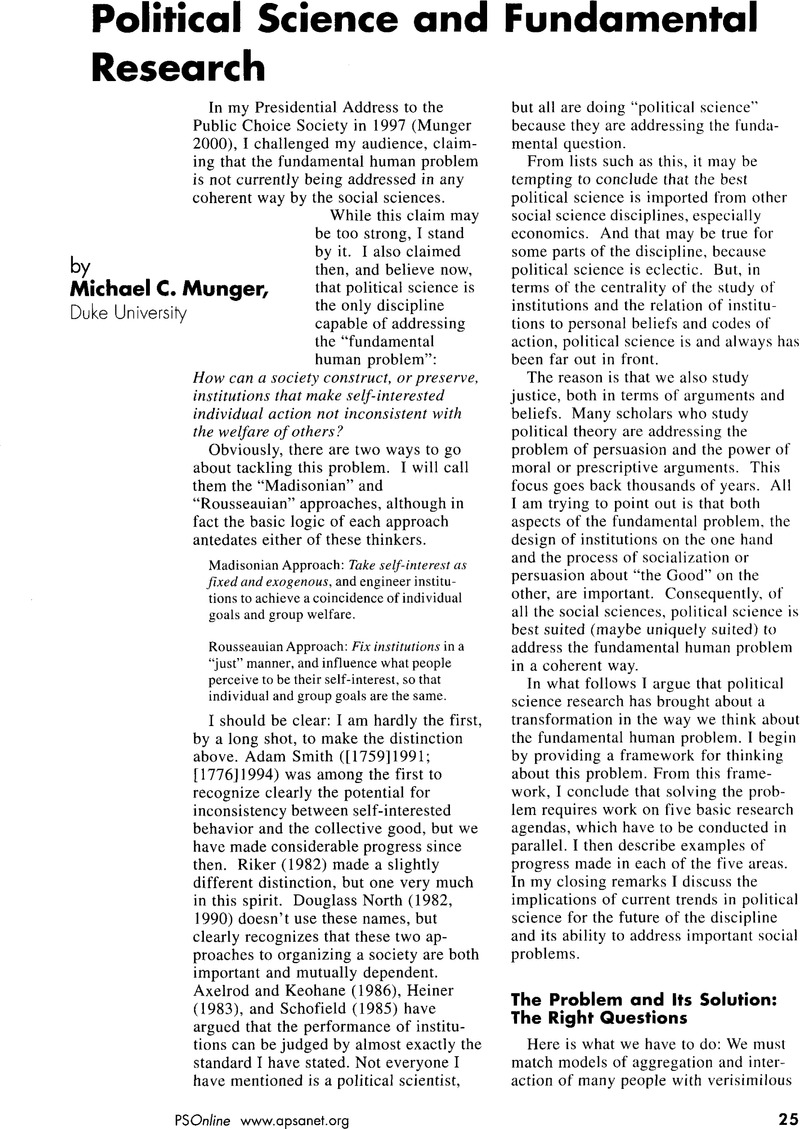No CrossRef data available.
Article contents
Political Science and Fundamental Research
Published online by Cambridge University Press: 02 September 2013
Abstract
An abstract is not available for this content so a preview has been provided. Please use the Get access link above for information on how to access this content.

- Type
- The Public Value of Political Research
- Information
- PS: Political Science & Politics , Volume 33 , Special Issue 1: The Public Value of Political Science Research , March 2000 , pp. 25 - 32
- Copyright
- Copyright © The American Political Science Association 2000
References
Alvarez, Michael. 1997. Information and Elections. 1st ed. Ann Arbor: University of Michigan Press.CrossRefGoogle Scholar
Aristotle. 1979. Politics and Poetics. Trans. Jowett, B. and Butcher, S.H.. Norwalk, CT: Easton Press.Google Scholar
Arrow, Kenneth J.
1963. Social Choice and Individual Values. New Haven: Yale University Press.Google Scholar
Austen-Smith, David. 1990. “Information Transmission in Debate.” American Journal of Political Science
34(February): 124–52.CrossRefGoogle Scholar
Austen-Smith, David, and Banks, Jeffrey. 1996. “Information Aggregation, Rationality, and the Condorcet Jury Theorem.” American Political Science Review
90(March): 34–45.CrossRefGoogle Scholar
Axelrod, Robert, and Keohane, Robert. 1986. “Achieving Cooperation under Anarchy: Strategies and Institutions.” In Cooperation under Anarchy, ed. Oye, Kenneth. Princeton: Princeton University Press.Google Scholar
Banks, Jeffrey. 1991. Signaling Games in Political Science. Chur, Switzerland: Harwood Academic Publishing.Google Scholar
Black, Duncan. 1958. The Theory of Committees and Elections. Cambridge: Cambridge University Press.Google Scholar
Brams, Steven J., and Taylor, Alan D.. 1996. Fair Division: From Cake-Cutting to Dispute Resolution. New York: Cambridge University Press.CrossRefGoogle Scholar
Brams, Steven J., and Taylor, Alan D.. 1999. The Win-Win solution: Guaranteeing Fair Shares to Everybody. New York: W.W. Norton.Google Scholar
Brennan, Geoffrey, and Buchanan, James M.. 1985. The Reason of Rules: Constitutional Political Economy. New York: Cambridge University Press.Google Scholar
Buchanan, James M.
1954. “Social Choice, Democracy, and Free Markets.” Journal of Political Economy
62: 114–23.CrossRefGoogle Scholar
Buchanan, James M.
1962. “The Relevance of Pareto Optimality.” Journal of Conflict Resolution
3: 341–54.CrossRefGoogle Scholar
Buchanan, James M.
1966. “An Individualistic Theory of Political Process.” In Varieties of Political Theory, ed. Easton, David. Englewood Cliffs, NJ: Prentice-Hall.Google Scholar
Buchanan, James M.
1975a. The Limits of Liberty: Between Anarchy and Leviathan. Chicago: University of Chicago Press.Google Scholar
Buchanan, James M.
1975b. “A Contractarian Paradigm for Applying Economic Theory.” American Economic Review
65: 225–30.Google Scholar
Buchanan, James M., and Tullock, Gordon. 1962. The Calculus of Consent: Logical Foundations of Constitutional Democracy. Ann Arbor: University of Michigan Press.Google Scholar
Brennan, Geoffrey, and Buchanan, James M.. 1985. The Reason of Rules: Constitutional Political Economy. New York: Cambridge University Press.Google Scholar
Calvert, Randall. 1985. “The Value of Biased Information: A Rational Choice Model of Political Advice.” American Journal of Political Science
37(August): 799–833.Google Scholar
Coleman, James, and Ferejohn, John. 1986. “Democracy and Social Choice.” Ethics
97:6–25.CrossRefGoogle Scholar
Converse, Phillip. 1964. “The Nature of Mass Belief Systems.” In Ideology and Its Discontents, ed. Apter, David. New York: Free Press.Google Scholar
Grofman, Bernard, and Feld, Scott. 1988. “Rousseau's General Will: A Condorcetian Perspective.” American Political Science Review
82(June): 567–76.CrossRefGoogle Scholar
Heiner, Ronald. 1983. “On the Origins of Predictable Behavior.” American Economic Review
73:560–95.Google Scholar
Hinich, Melvin, and Munger, Michael. 1994. Ideology and the Theory of Political Choice. Ann Arbor: University of Michigan Press.CrossRefGoogle Scholar
Iyengar, Shanto. 1991. Is Anyone Responsible? How Television Frames Political Issues. Chicago: University of Chicago Press.CrossRefGoogle Scholar
Jones, Bryan. 1995. Reconceiving Democratic Decision-Making. Chicago: University of Chicago Press.Google Scholar
Kettl, Donald. 1997. “The Global Revolution in Public Management: Driving Themes, Missing Links.” Journal of Policy Management and Management
16(Summer): 446–62.Google Scholar
Ladha, Krishna. 1992. “The Condorcet Jury Theorem, Free Speech, and Correlated Votes.” American Journal of Political Science
36(August): 617–34.CrossRefGoogle Scholar
Ladha, Krishna. 1996. “Hypothesis Testing and the Jury Theorem.” In Collective Decision Making: Social Choice and Political Economy, ed. Schofield, Norman. Boston: Kluwer Academic.Google Scholar
Ladha, Krishna, and Miller, Gary. 1996. “Political Discourse, Factions, and the General Will: Correlated Voting and Condorcet's Jury Theorem.” In Collective Decision Making: Social Choice and Political Economy, ed. Schofield, Norman. Boston: Kluwer Academic.Google Scholar
Lodge, Milton, Steenbergen, Marco, and Brau, Shawn. 1995. “The Responsive Voter: Campaign Information and the Dynamics of Candidate Evaluation.” American Political Science Review
89(June): 309–26.CrossRefGoogle Scholar
Lupia, Arthur. 1994. “Shortcuts versus Encyclopedias: Information and Voting Behavior in California Insurance Reform Elections.” American Political Science Review
88(March): 63–76.CrossRefGoogle Scholar
Lupia, Arthur, and McCubbins, Mathew. 1998. The Democratic Dilemma: Can Citizens Learn What They Need to Know?
New York: Cambridge University Press.Google Scholar
McKelvey, Richard, and Ordeshook, Peter. 1986. “Information, Electoral Equilibria, and the Democratic Ideal.” Journal of Politics
8:909–937.CrossRefGoogle Scholar
Monroe, Burt. 1995. “Fully Proportional Representation.” American Political Science Review
89(December): 925–40.CrossRefGoogle Scholar
Munger, Michael. 2000. “Five Questions: An Integrated Agenda for Public Choice.” Public Choice (in press).Google Scholar
North, Douglass. 1982. Structure and Change in Economic History. New York: W. W. Norton and Company.Google Scholar
North, Douglass. 1990. Institutions, Institutional Change, and Economic Performance. New York: Cambridge University Press.CrossRefGoogle Scholar
Riker, William. 1982. Liberalism Against Populism: A Confrontation Between the Theory of Democracy and the Theory of Social Choice. San Francisco: Freeman.Google Scholar
Schofield, Norman. 1985. “Anarchy, Altruism, and Cooperation: A Review.” Social Choice and Welfare
2(2): 207–19.CrossRefGoogle Scholar
Smith, Adam. [1759] 1991. The Theory of Moral Sentiments. Indianapolis: Liberty Fund Press.CrossRefGoogle Scholar
Smith, Adam. [1776]1994. An Inquiry into the Nature and Causes of the Wealth of Nations. New York: Modern Library.Google Scholar
Tullock, Gordon. 1967. “The General Irrelevance of the General Impossibility Theorem.” Quarterly Journal of Economics
81: 256–70.CrossRefGoogle Scholar
Young, H. Peyton, 1994. Equity: In Theory and Practice. Princeton: Princeton University Press.Google Scholar
Zaller, John. 1992. The Nature and Origins of Public Opinion. New York: Cambridge University Press.CrossRefGoogle Scholar




